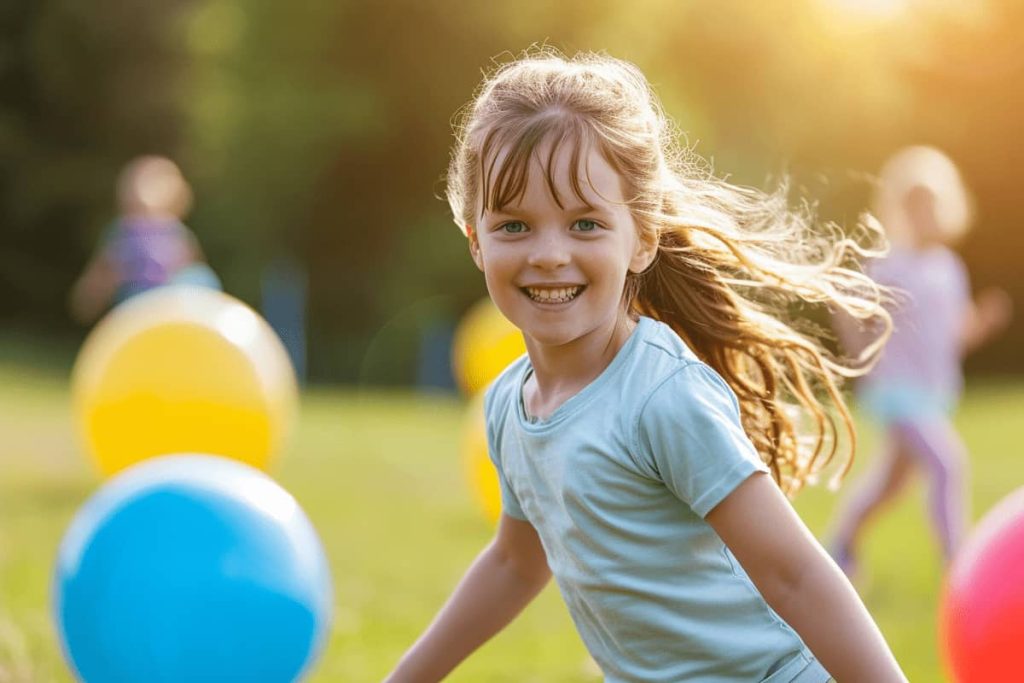It’s more important than ever for kids to ‘Get Active’! Our little ones need engaging and fun ways to move their bodies, and we have just the right mix of activities to keep them thrilled and healthy. This article is your ultimate guide to transforming exercise into an adventure that every child will love.
Let’s step outside, breathe in the fresh air, and dive into a world where fitness meets fun!
Key Takeaways:
- Creating a fun exercise environment is key to encouraging kids to get active and excited about physical activity.
- Kids can hop, do push-ups, and take turns in different exercises to enjoy a fun and active playtime.
- Plenty of indoor activities and fun outdoors can be adapted to suit different ages and abilities.
Benefits of Physical Activity for Children
Physical activity is essential for children’s overall health and well-being. It can help build strong muscles and bones, enhance mental health, foster social skills and confidence, and improve physical health and endurance.
Building Strong Muscles and Bones
Physical activity, especially muscle-strengthening exercises for kids, is crucial for developing strong muscles and bones in children.
Engaging in fitness activities for kids like running, jumping, and playing sports can help increase bone density and improve muscle strength, which can reduce the risk of injury and promote healthy growth.
Enhancing Mental Health
Physical activities for kids can have a positive impact on children’s mental health by:
- Reducing anxiety and depression
- Improving their attitude and listening skills
It can also serve as a healthy outlet for stress and emotions, helping children develop coping mechanisms and resilience. Kids at home can enjoy fun workout options and exercise games through physical activities.
KinVibes Pro-Tip: To maximize the mental health benefits of physical activity for children, consider integrating mindfulness exercises like deep breathing or meditation during cool-down periods. This combination of physical and mental wellness activities can significantly enhance their overall well-being.
Fostering Social Skills and Confidence
Participating in physical activities with others, including games for kids, can help children develop important social skills like teamwork, communication, and leadership.
Kids need these physical fitness activities to boost their confidence and self-esteem. It can give them a sense of accomplishment and pride in their abilities.
Physical Health and Endurance
Engaging in moderate to vigorous physical activity can improve children’s overall health and endurance through:
- Strengthening their heart and lungs
- Reducing the risk of obesity and chronic diseases
- promoting healthy growth and development
Get active as a family, where both kids and adults at home can win together. Even simple activities like a sock throwing contest can ensure kids can get enough exercise and kids will love the experience.
Overall, physical activity is critical for children’s health and well-being, and parents and caregivers should encourage and support children in engaging in various fitness activities.
| Benefit | Description | Example Activities |
|---|---|---|
| Building Strong Muscles and Bones | Physical activity strengthens children’s muscles and bones, enhancing growth and reducing injury risk. | Running, Jumping, Sports like soccer and basketball |
| Enhancing Mental Health | Engaging in physical activities helps in reducing anxiety and depression, and improves mood and cognitive functions. | Yoga, Dancing, Mindful walking |
| Fostering Social Skills and Confidence | Participating in group activities develops teamwork, communication skills, and boosts self-esteem. | Team sports, Group dance classes, Relay races |
| Improving Physical Health and Endurance | Regular exercise strengthens the heart and lungs, reduces obesity risk, and promotes overall healthy development. | Swimming, Cycling, Aerobics |
Creating a Fun Exercise Environment
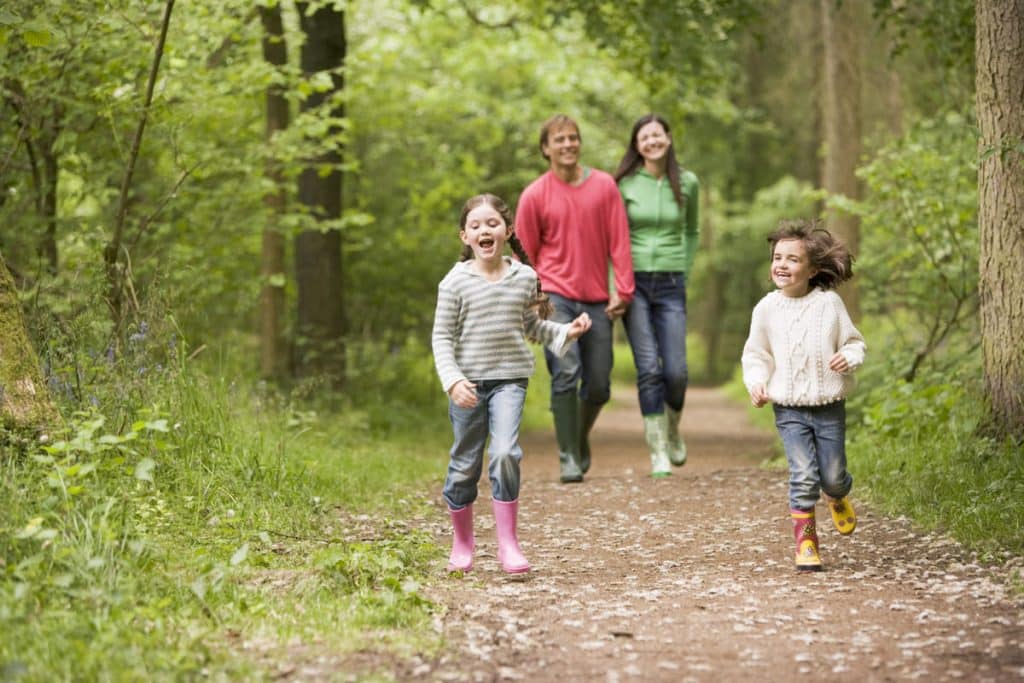
When it comes to keeping children active, creating fun exercises for kids is key. By making exercise fun, kids are more likely to enjoy it and want to continue doing it.
Involving the Family
One way to make exercise fun for kids is to involve the whole family. Parents can be great role models for their kids by participating in physical activities with them, this can include:
- Going for walks or bike rides together
- Playing a game of tag
- Dancing around the living room to some music
- Doing mild pushups together
By getting the family moving together, kids are more likely to see exercise as a fun and enjoyable activity.
Incorporating Play and Imagination
Another way to make exercise fun for kids is to incorporate play and imagination into their activities.
This can include playing active games like charades, where kids sit on the couch until it’s their turn, or capturing the flag with an imaginative twist like pretending to be a crab scuttling to the flag.
KinVibes Pro-Tip: Boost your kids’ exercise fun by encouraging them to pretend to be animals, superheroes, or astronauts. This imaginative play makes staying active both enjoyable and creative.
Utilizing Technology
Finally, parents can also utilize technology to make exercise fun for kids. There are many active games and activities for kids available on YouTube and other websites, such as GoNoodle.
Parents can also use screen time to their advantage by setting up a family dance party or playing an active video game together.
Indoor Activities for Year-Round Fun

When it’s too cold or rainy to play outside, there are still plenty of ways for kids to stay active indoors. Here are a few ideas for fun exercise activities that can be enjoyed year-round.
Dance Party and Freeze Dance
Put on some upbeat music and have a dance party! Kids can show off their moves and get their heart rates up at the same time.
For an added challenge, try playing freeze dance. When the music stops, everyone has to freeze in place until the music starts again. This activity never gets old and is perfect before bedtime.
Obstacle Courses and Scavenger Hunts
Indoor Obstacles
Create an indoor obstacle course using household items like chairs, pillows, and empty water bottles. Kids can crawl under chairs, jump over pillows, and run around obstacles to complete the course.
Another fun idea is to put together a list for a scavenger hunt. Hide items around the house and see how long it takes for them to find them. This will get them moving and thinking at the same time.
Balancing Games and Yoga
Balance is an important skill for children to develop. Try playing games that challenge their balance, like standing on one foot or walking heel-to-toe for 30 feet from a start line to see who’s the fastest.
You can also introduce them to yoga. There are many simple yoga moves that kids can do which are great for active play:
- Downward dog
- Tree pose
Not only will this help with coordination and movement, but it can also be a calming activity for kids.
Indoor Mini Golf
Transform your home into a miniature golf course for an exciting indoor activity. Use everyday household items to create a variety of unique and challenging holes.
For instance, books can serve as ramps, cups as holes, and rolled-up socks as golf balls. Children can participate in designing the course, which not only stimulates their creativity but also helps develop their motor skills as they navigate through the mini-golf course.
This fun and engaging activity is perfect for rainy days or when outdoor play is not an option.
Hula Hoop Contest
A hula hoop contest is a fantastic way to get kids moving and laughing. It’s simple: just spin the hoop around your waist and see who can keep it going the longest. You can also introduce variations, such as moving the hoop up and down the arms or jumping while hula hooping.
This activity is not only a fun challenge but also an excellent way to improve coordination and core strength.
Indoor Basketball
Indoor basketball, using a soft ball and a makeshift hoop, can be a safe and enjoyable way for kids to play basketball inside. The hoop can be a simple basket or a hoop attached to the back of a door. Using a soft, lightweight ball ensures safety while playing indoors.
This activity encourages physical fitness, hand-eye coordination, and teamwork. Kids can practice shooting hoops, passing, and even dribbling skills.
It’s a great way to bring the excitement of basketball into your home, fostering a love for the sport and physical activity in a fun and safe environment.
Looking for more inspiration? Check out our ‘Fun March Activities for Kids‘ for seasonal ideas that are sure to captivate and educate.
Pillow Fort Building
Pillow fort building is a delightful and imaginative indoor activity for children. Using pillows, blankets, and sofa cushions, kids can create their own little forts or elaborate castles.
This activity not only sparks creativity but also helps in developing spatial awareness and problem-solving skills as they figure out how to construct stable structures. Moreover, once the fort is built, it becomes a perfect setting for storytelling, playing games, or simply enjoying a cozy reading time.
Pillow fort building is a wonderful way for children to use their imagination and enjoy an adventure right in the living room.
Indoor Bowling
Indoor bowling using plastic bottles and a soft ball is a fun and safe way to enjoy bowling right at home. Set up empty plastic bottles in a traditional bowling pin formation at the end of a hallway or on a smooth floor. Children can then take turns rolling a soft ball to knock down the pins.
This game helps in enhancing hand-eye coordination and motor skills. It’s also a great way for kids to learn about aiming and spatial judgment, all while having a blast with family members.
Plus, it’s an excellent activity for developing a sense of friendly competition and sportsmanship among siblings and friends.
Simon Says (Physical Version)
“Simon Says” is a classic game that can be given a physical twist to get kids moving. The leader, or ‘Simon’, gives commands like “Simon says jump” or “Simon says touch your toes.”
Children can only follow the command if it starts with “Simon says”. This physical version of Simon Says is not only entertaining but also great for improving listening skills, reaction time, and body awareness.
Indoor Rock Climbing
Indoor rock climbing offers an exhilarating and challenging experience for kids to stay active.
- Developmental Benefits: Helps develop strength, coordination, and flexibility in children.
- Cognitive Skills: Enhances problem-solving skills as children determine the best path to climb.
- Confidence Building: Acts as a confidence booster by teaching children to overcome obstacles and achieve new heights.
- Safety Measures: Should be conducted under expert supervision with appropriate safety gear to ensure a safe and enjoyable experience.
Outdoor Adventures and Games
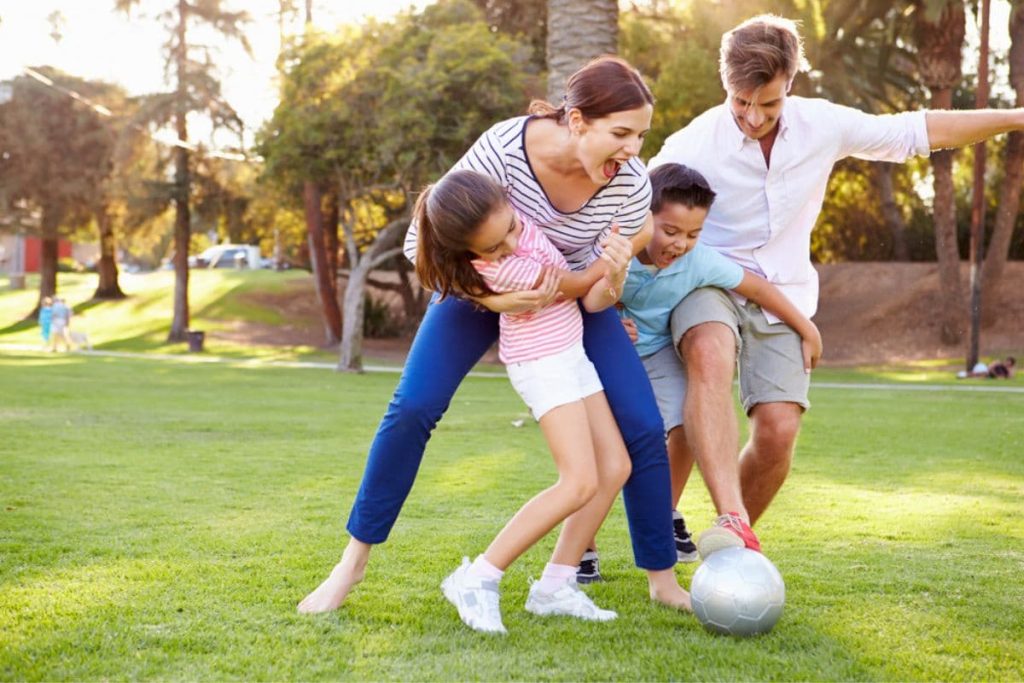
Outdoor adventures and games are a great way to get kids moving and active. Here are some fun ideas for outdoor activities that will keep children engaged and entertained.
Neighborhood Exploration
Exploring the neighborhood is a great way to get kids moving and learning about their surroundings.
Take a walk or bike ride around the block, and encourage children to look for interesting things along the way, like unique architecture, plants, and animals, or landmarks.
They can also construct a map of their exploration on pieces of paper.
Sports and Team Activities
Sports and team activities are a great way to get kids active and teach them valuable skills like teamwork and sportsmanship. Activities like catching, kicking a ball, or playing a game of tag can be done with just a few people or as part of a larger group.
For those who enjoy team sports, these can be a great way to get involved in a community and meet new friends.
- Soccer
- Basketball
- Softball
Several adolescent teens and preschool kiddos can all benefit from these activities.
Water Play and Swimming
Water play and swimming are great ways to stay cool during the summer months while also getting exercise. Whether it’s at the beach or a local pool, swimming is a low-impact activity that is great for kids of all ages.
Water play activities can also be a fun way to get moving and stay cool, these are mainly:
- Water balloon fights
- Running through sprinklers
Nature Scavenger Hunt
A nature scavenger hunt is an exciting way to explore the outdoors.
Children can be given a list of items to find in nature, such as a certain type of leaf, a feather, or a uniquely shaped rock. This activity encourages observation skills and a deeper appreciation of the natural world. As they search for items on their list, children learn about the environment and develop a sense of adventure.
It’s a great activity for enhancing problem-solving skills and can be enjoyed in a backyard, park, or on a nature trail.
Frisbee Golf
Frisbee golf, also known as disc golf, combines the fun of frisbee throwing with the goals of golf. Set up ‘holes’ around your yard or a park, using targets like trees, posts, or homemade markers. Players take turns throwing their frisbees, aiming to hit each target in as few throws as possible.
This game is fantastic for developing hand-eye coordination and offers a unique way to enjoy the outdoors. It’s a casual, relaxed sport that can be easily learned and enjoyed by children of all ages.
Rollerblading
Rollerblading is a thrilling and enjoyable way for kids to be active outdoors. It helps improve balance, coordination, and endurance. Children can rollerblade in a park, on a sidewalk, or at a rollerblading rink.
Safety gear such as helmets, knee pads, and elbow pads are essential to ensure a safe experience. Rollerblading can be a fun family activity, promoting fitness and offering an excellent opportunity for kids to learn a new skill while enjoying the fresh air.
Kite Flying
Kite flying is a classic outdoor activity that never fails to delight. It’s perfect for breezy days and open spaces. Flying a kite requires and enhances coordination, patience, and spatial awareness.
It’s also a relaxing activity that can reduce stress and boost mood. Watching a kite soar high in the sky can be a mesmerizing experience for children, making it a wonderful way to spend quality time outdoors.
Gardening as a Family

Family gardening is a rewarding way to spend time together outdoors.
Children can learn about plants, nature, and the responsibility of caring for a garden.
Tasks like planting seeds, watering plants, and harvesting produce can be both educational and enjoyable. Gardening also fosters a sense of accomplishment as children see the fruits of their labor grow and thrive.
It’s a peaceful activity that promotes a connection with nature and offers a hands-on experience in environmental stewardship.
Outdoor Yoga for Kids
Outdoor yoga for kids is a fantastic way to combine the benefits of yoga with the beauty of nature. Simple yoga poses and breathing exercises can be taught, helping children improve flexibility, balance, and relaxation.
Practicing yoga outdoors allows children to connect with their surroundings, enhancing mindfulness and calmness. It’s an activity that can be tailored to children of all ages and skill levels, promoting both physical health and mental well-being.
Treasure Hunt
Organizing a treasure hunt is an exhilarating way to encourage exploration and problem-solving. Create a map or a series of clues leading to a hidden ‘treasure’. The treasure can be anything from a box of treats to a selection of small toys. As children follow the clues, they engage in physical activity and creative thinking.
This adventure game is perfect for outdoor spaces like parks or backyards and can be adapted to suit different age groups, ensuring everyone involved has a fun and engaging experience.
Exercise Through Daily Routines
Keeping children active doesn’t always have to involve structured exercise or playtime. Incorporating physical activity into daily routines can be an effective way to ensure that kids are getting enough exercise.
Here are some ideas for making physical activity a part of your child’s daily routine:
Active Transportation
Encourage your child to walk, ride a bike, or use a scooter to get to school or other nearby destinations. This not only provides a healthy way to get around but also helps to develop gross motor skills and cardiovascular function. For a fun twist, kids may want to use a dice to decide which path to take.
They could even set up a race to see how far they can squeeze in carrying couch cushions or a blanket from one end of the driveway to the other.
Chores and Responsibilities
Assigning chores and responsibilities that involve physical activity can be a great way to keep kids moving.
For example, raking leaves, shoveling snow, or carrying groceries can build strength and endurance. Additionally, chores can teach children critical thinking and decision-making skills.
Structured Exercise and Play
Structured exercise and playtime are important for developing a healthy body and mind.
1. Consider enrolling your child in physical education classes or sports teams to provide structured exercise and competition.
2. Playground equipment, karate classes, or even creating an obstacle course with different types of balls around a lamp or a tree stump can also be great ways to keep kids active and engaged.
Grown ups can join in too in different exercises to show the health benefits of staying active at all ages.
Walking the Dog Together
Walking the dog as a family is a simple yet effective way to incorporate exercise into your daily routine. It not only provides physical activity but also strengthens the bond between family members and their pet.
This activity encourages responsibility in children, as they learn to take care of their furry friend. Walking together allows for exploration of the neighborhood, promotes conversations, and offers a relaxing break from the day’s routine.
It’s a great way for the whole family to enjoy the outdoors and stay active together.
Jumping Rope During Breaks
Incorporating jumping rope into short breaks throughout the day is an excellent way for kids to stay active.
This high-energy activity is a fantastic cardiovascular exercise that improves coordination, stamina, and agility.
Jumping rope can be done individually or as a group activity, making it both a fun solo challenge and an enjoyable social activity. It’s also portable and can be done almost anywhere, providing a quick and effective way to energize and refocus during breaks from more sedentary activities.
Stretching or Yoga in the Morning
Starting the day with stretching or yoga can have a positive impact on children’s physical and mental well-being. Gentle stretches or basic yoga poses can help wake up the body, improve flexibility, and set a calm tone for the day ahead.
This practice can also help in developing concentration and relaxation skills, which are beneficial for children of all ages. Incorporating this into the morning routine can be a peaceful and invigorating way to begin each day.
Family Gardening Time
Gardening together as a family is a fantastic way to engage in physical activity while nurturing a connection with nature. Digging, planting, weeding, and watering are all tasks that involve moderate physical exertion, beneficial for children and adults alike.
Gardening teaches children about the environment, the source of their food, and the satisfaction of growing something themselves. It’s a rewarding and educational activity that the whole family can enjoy together.
Bike Ride to a Local Park
Taking a bike ride to a local park combines the joys of cycling with the fun of outdoor play.
Biking is an excellent form of exercise that improves cardiovascular fitness, muscle strength, and coordination. It’s also an eco-friendly mode of transportation.
Cycling as a family to a nearby park for a picnic or playtime is a great way to spend quality time together, explore new areas, and enjoy the benefits of being active in the fresh air.
Interactive Walking Tours of Historical Areas
Participating in interactive walking tours of historical areas is an educational and physically active way to explore history and culture.
These tours often involve walking through historic neighborhoods or sites, providing a unique learning experience outside the traditional classroom setting. This activity promotes curiosity, engagement with the community’s heritage, and physical fitness.
It’s an enriching experience that combines exercise with learning, ideal for families looking to explore their surroundings in an informative and active way.
Age-Appropriate Exercise Ideas
| Age Group | Exercise Activity | Description | Skills Developed |
|---|---|---|---|
| Toddlers and Preschoolers | Dancing to music | Encourages free movement and rhythm. | Coordination, Rhythm, Expressiveness |
| Playing with balls | Enhances hand-eye coordination and motor skills. | Hand-Eye Coordination, Motor Skills | |
| Running around in open space | Promotes physical fitness and freedom. | Cardiovascular Health, Exploration | |
| Playing with hula hoops | Develops coordination and physical fitness. | Balance, Coordination | |
| Simple yoga poses | Introduces basic stretching and balance. | Flexibility, Balance | |
| Playing catch with soft balls | Encourages active play and coordination. | Hand-Eye Coordination, Social Skills | |
| Crawling through tunnels | Improves motor skills and spatial awareness. | Motor Skills, Spatial Awareness | |
| Jumping on a mini trampoline | Promotes fitness and balance. | Physical Fitness, Balance | |
| School-Age Children | Jumping rope | Enhances cardiovascular fitness and coordination. | Cardiovascular Health, Coordination |
| Playing tag | Encourages running and agility. | Agility, Speed | |
| Riding bikes | Develops balance and endurance. | Balance, Endurance | |
| Playing hopscotch | Promotes agility and coordination. | Motor Skills, Coordination | |
| Running races | Improves speed and cardiovascular health. | Speed, Cardiovascular Fitness | |
| Sports (soccer, basketball) | Enhances teamwork and physical skills. | Teamwork, Physical Skills | |
| Jumping jacks, calisthenics | Promotes overall fitness and strength. | Strength, Endurance | |
| Swimming | Builds strength and is a low-impact exercise. | Strength, Low-Impact Fitness | |
| Teens and Young Adults | Running or jogging | Improves cardiovascular fitness and endurance. | Cardiovascular Health, Endurance |
| Team sports (tennis, basketball) | Encourages teamwork and strategy. | Teamwork, Strategic Thinking | |
| Swimming laps, water aerobics | Provides a full-body workout. | Full-Body Workout, Stamina | |
| Dancing to music | Boosts mood and provides a fun workout. | Mood Enhancement, Coordination | |
| Strength training | Builds muscle strength and endurance. | Muscle Strength, Endurance | |
| Hiking, walking in nature | Promotes mindfulness and physical fitness. | Mindfulness, Physical Fitness | |
| Yoga, Pilates | Enhances flexibility and mental well-being. | Flexibility, Mental Well-Being | |
| High-intensity interval training (HIIT) | Offers a challenging and efficient workout. | Cardiovascular Health, Efficiency |
Toddlers and Preschoolers
Toddlers and preschoolers need plenty of physical activity to help them develop their motor skills and coordination. Here are some age-appropriate exercise ideas for young children:
- Dancing to music
- Playing with balls of different sizes
- Running around in an open space
- Playing with hula hoops
- Doing simple yoga poses
- Playing catch with soft balls
- Crawling through tunnels
- Jumping on a mini trampoline
Simon Says with Simple Movements
“Simon Says” with simple movements is an engaging and educational game for toddlers and preschoolers. The leader gives commands like “Simon says jump in place” or “Simon says touch your nose.” This game is great for teaching body awareness and following instructions, while the physical aspect helps in developing motor skills.
Follow the Leader
In “Follow the Leader,” one child leads the group and performs various movements like walking, clapping, or hopping. The rest of the children follow suit, mimicking the leader’s actions.
This activity not only keeps them physically active but also encourages creativity and leadership skills in young children.
Parachute Play
Parachute play involves using a large, colorful parachute to create different movements, like making waves or lifting it high and running underneath. This playful activity is excellent for developing teamwork and coordination. It also stimulates sensory awareness with its colors and movements.
Bubble Popping (run to pop bubbles)
Bubble popping involves children running around to pop bubbles that are either blown by an adult or a bubble machine. It’s a fun way to encourage physical activity as children excitedly jump, run, and reach to pop the bubbles. This activity enhances hand-eye coordination and gross motor skills.
KinVibes Pro-Tip: Remember to supervise young children during physical activities and ensure that the exercise area is free from clutter or potential hazards.
School-Age Children
School-age children need at least one hour of moderate-to-vigorous-intensity aerobic activity every day, as well as bone-strengthening activity and muscle-strengthening activity at least three days a week.
- Jumping rope
- Playing tag
- Riding bikes
- Playing hopscotch
- Running races
- Playing sports such as soccer, basketball, or volleyball
- Doing jumping jacks or other calisthenics
- Swimming or playing in the water
Encourage children to find activities they enjoy and to keep trying new things to stay physically active.
Ultimate Frisbee
Ultimate Frisbee is a team sport that combines elements of soccer, basketball, and football, but using a frisbee. It’s excellent for developing cardiovascular fitness, coordination, and teamwork skills. The game’s fast pace and strategic play make it an exciting activity for school-aged children.
Skating
Skating, whether on rollerblades or skateboards, is a fantastic way for children to improve their balance, agility, and muscle strength. It’s a fun and challenging activity that can be enjoyed in parks, skating rinks, or even on sidewalks, with appropriate safety gear.
Tug of War
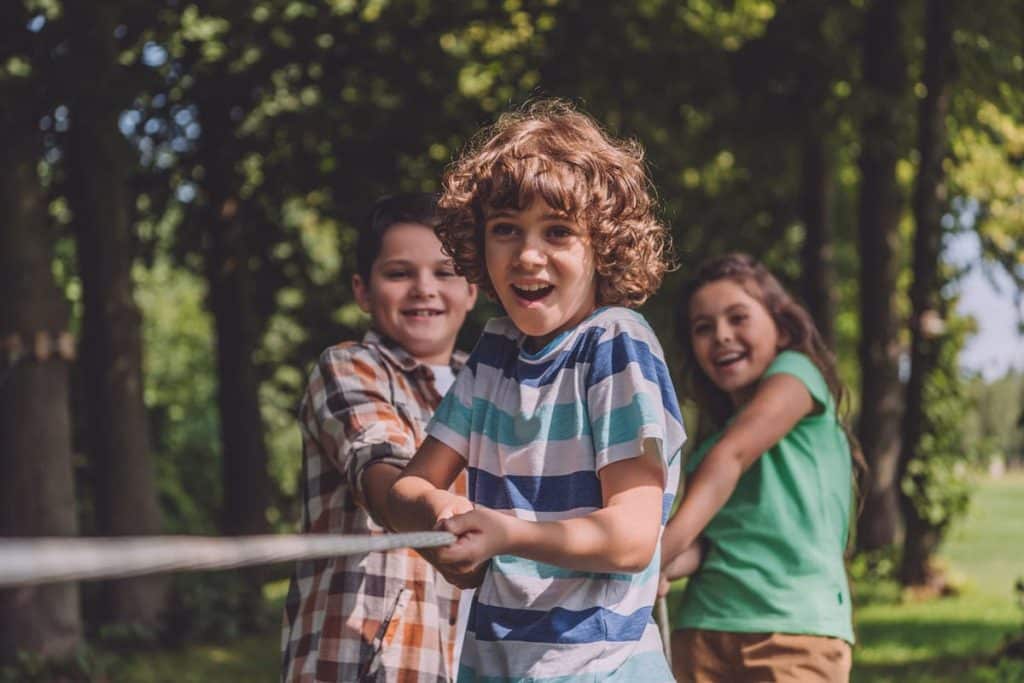
Tug of War is a classic game that involves two teams pulling on opposite ends of a rope, each trying to bring the other team across a central line. It’s a great way to build strength, teamwork, and strategy among school-aged children.
Building and Walking Through a Maze
Creating a maze with obstacles, either indoors or outdoors, and then navigating through it can be a thrilling challenge for children. This activity stimulates problem-solving skills and physical agility as they figure out how to navigate the maze.
Teens and Young Adults
Teens and young adults should aim for at least one hour of moderate-to-vigorous-intensity aerobic activity every day, as well as muscle-strengthening activity at least three days a week.
Keep in mind to choose activities that are appropriate to your fitness level and to warm up before starting any vigorous-intensity aerobic activity.
Here are some exercise ideas for teens and young adults:
- Running or jogging
- Playing sports such as tennis, basketball, or soccer
- Swimming laps or doing water aerobics
- Dancing to music
- Strength training with weights or resistance bands
- Hiking or walking in nature
- Doing yoga or Pilates
- High-intensity interval training (HIIT)
Ultimate Frisbee
Ultimate Frisbee is a team sport that combines elements of soccer, basketball, and football, but using a frisbee. It’s excellent for developing cardiovascular fitness, coordination, and teamwork skills.
The game’s fast pace and strategic play make it an exciting activity for school-aged children.
Skating
Skating, whether on rollerblades or skateboards, is a fantastic way for children to improve their balance, agility, and muscle strength. It’s a fun and challenging activity that can be enjoyed in parks, skating rinks, or even on sidewalks, with appropriate safety gear.
Tug of War
Tug of War is a classic game that involves two teams pulling on opposite ends of a rope, each trying to bring the other team across a central line.
It’s a great way to build strength, teamwork, and strategy among school-aged children.
Building and Walking Through a Maze
Creating a maze with obstacles, either indoors or outdoors, and then navigating through it can be a thrilling challenge for children. This activity stimulates problem-solving skills and physical agility as they figure out how to navigate the maze.
Parkour Basics
Parkour, the art of moving efficiently and creatively through an environment, is an exhilarating activity for teens and young adults. Starting with basic techniques, it teaches how to navigate obstacles by running, jumping, and climbing.
Parkour enhances physical strength, agility, coordination, and spatial awareness. It also promotes quick decision-making and boosts confidence.
Zumba or Dance Workouts
Zumba or dance workouts are a fun and energetic way to stay fit. These workouts combine dance moves with aerobic elements, providing a full-body workout that improves cardiovascular health, coordination, and balance.
They are also great for boosting mood and self-expression, making them popular among teens and young adults.
Outdoor Adventure Courses
Outdoor adventure courses, such as ropes or obstacle courses, offer physical and mental challenges. They often include elements like zip-lines, rope bridges, and climbing walls.
These activities provide a physical workout and enhance problem-solving skills, teamwork, and confidence in handling challenging situations.
Martial Arts or Self-Defense Classes
Martial arts, particularly Brazilian jiu-jitsu are excellent for physical conditioning, self-discipline, and self-confidence. They teach valuable defense techniques while also promoting respect, focus, and mental strength.
These classes can be a powerful tool for personal growth and empowerment for teens and young adults.
Incorporating Exercise into School Life
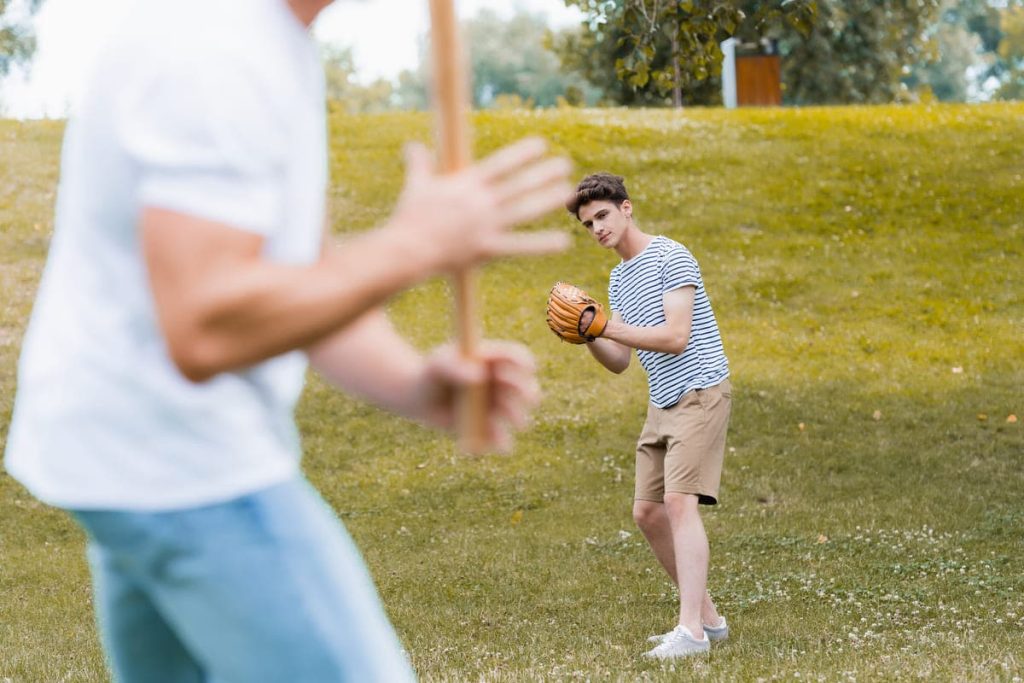
Physical activity is not only important for a child’s physical health but also for their mental and emotional well-being. Incorporating exercise into school life can help children stay active and healthy.
Physical Education Classes
Physical education classes are an excellent way to introduce children to various sports and physical activities. These classes can help children develop fundamental movement skills such as:
- Running
- Jumping
- Throwing
- Catching
It is essential to ensure that physical education classes are inclusive and provide opportunities for all children to participate regardless of their ability level.
Active Breaks and Recess
Active breaks and recess are an excellent way to help children stay active throughout the school day. These activities not only provide physical benefits but also help children develop social skills and teamwork.
KinVibes Pro-Tip: Teachers can energize students by integrating quick exercises like jumping jacks or Simon Says into the classroom. Encourage traditional games like hopscotch or tag during recess for physical and social benefits.
After-School Sports and Clubs
After-school sports and clubs are another way to keep children physically active. Schools can offer a variety of sports and activities.
| Activity | Benefits for Kids |
|---|---|
| Basketball | Enhances coordination, teamwork, and cardiovascular health. |
| Soccer | Develops endurance, coordination, and teamwork skills. |
| Karate | Improves strength, balance, discipline, and self-confidence. |
| Dance Parties | Encourages creativity, rhythm, physical fitness, and social skills. |
These activities provide children with the opportunity to:
- Learning new skills
- Making friends
- Staying active outside of school hours
Safety Tips and Considerations
When it comes to exercise activities for kids, safety should always be a top priority. Here are some tips and considerations to keep in mind to ensure that your child stays safe and healthy while they are having fun:
Proper Equipment and Gear
Before starting any physical activity, make sure your child has the proper equipment and gear.
For example, if they are riding a bike or scooter, they should always wear a helmet to protect their head in case of a fall.
Additionally, if they are playing a sport, they should wear the appropriate protective gear, such as shin guards or elbow pads.
Hydration and Nutrition
Staying hydrated and eating healthy snacks can help your child stay energized and focused during physical activity.
- Make sure they drink plenty of water before, during, and after exercise, especially on hot days.
- Provide kids with healthy snacks, such as fruit or granola bars, to give them the energy they need to keep going.
Sun Protection and Injury Prevention
Sunscreen is important to protect your child’s skin from harmful UV rays. Make sure they apply sunscreen before heading outside for exercise, and reapply it every few hours. Additionally, warming up before exercise and stretching afterward can help prevent injuries.
Encouraging Long-Term Healthy Habits
Setting a Positive Example
Parents are the most important role models for their children. If parents lead a healthy lifestyle, children are more likely to follow in their footsteps. Therefore, parents should make an effort to include physical activity in their daily routine, they can do this by:
- Taking a walk after dinner
- Going for a bike ride on weekends
- Playing a game of catch in the backyard
Children will learn to associate exercise with fun and enjoyment if they see their parents enjoying physical activity.
Creating a Supportive Environment
Parents can create a supportive environment by setting aside time for physical activity, making sure their children have access to equipment and facilities, and encouraging their children to try new activities.
Moreover, parents can also listen to their children’s preferences and interests and incorporate those into the family’s exercise schedule.
Tracking Progress and Celebrating Success
Parents can track their children’s progress by keeping a record of their physical activity, setting milestones, and rewarding their children for achieving those milestones.
Rewards and ACCOMPLISHMENTS
Rewards can be as simple as a hug or a high-five or can be more substantial, such as a new piece of equipment or a special outing. Celebrating success will help children feel proud of their accomplishments and encourage them to continue making progress toward their goals.
Adapting Activities for Different Abilities
Physical activity is important for all children, regardless of their abilities. However, some children may require modified activities to ensure they can participate safely and effectively.
Inclusive Games and Sports
It’s important to choose games and sports that are inclusive and allow children with varying abilities to participate alongside their peers. Some examples of inclusive games include:
- Obstacle courses with a variety of challenges, such as crawling, jumping, and balancing
- Balloon polo, which can be played from a seated or standing position
- Beanbag toss, which can be modified with larger targets or closer distances
Modifying Exercises for Individual Needs
When working with children with different abilities, it’s important to modify exercises to meet their individual needs. This may include:
- Adjusting the intensity or duration of an exercise
- Providing additional support or equipment, such as a stability ball or resistance bands
- Offering alternative exercises that work the same muscle groups
Good To Know: It’s always important to work with each child to determine their individual needs and make modifications accordingly.
Encouraging Participation and Engagement
To ensure all children feel motivated and engaged during physical activity, it’s important to:
- Provide positive feedback and encouragement
- Allow for personalization and choice when possible
- Emphasize teamwork and cooperation
- Create a fun and enthusiastic environment
It’s time for parents to prioritize safety during physical activity. This may include providing adequate supervision, ensuring equipment is in good condition, and modifying exercises to reduce the risk of injury.
Wheelchair Tag
Wheelchair tag is a modified version of the classic game of tag, adapted for children in wheelchairs. It involves designating one player as “it,” who then tries to tag other players. This game encourages mobility and agility, fostering an inclusive environment where children with different abilities can play together. It’s a great way to enhance physical fitness and promote social interaction.
Sensory Walk (for children with sensory processing disorders)
A sensory walk is designed for children with sensory processing disorders, offering a path with various textures, colors, and objects to interact with.
This activity stimulates different senses, helping children to explore and understand sensory input in a controlled and safe environment. Sensory walks can be both calming and educational, aiding in the development of sensory integration skills.
Adapted Dance Class
Adapted dance classes offer the joy of dance to children with varying physical and developmental abilities. These classes may include modifications to traditional dance moves, use of assistive devices, or tailored music and lighting to accommodate sensitivities.
Adapted dance not only promotes physical fitness and coordination but also provides a platform for expression and creativity, fostering a sense of inclusion and community.
Frequently Asked Questions About exercise activities for kids
What are some entertaining physical games that kids can play?
There are many fun physical games that kids can play, such as tag, hide and seek, hopscotch, four square, jump rope, and obstacle courses. Duck, Duck, Goose (For younger children).
How can I get my 4-5 year olds excited about physical activity?
You can try playing music and dancing, creating an obstacle course, or playing games like Simon Says Red Light, or Green Light. Sack Races (Can be adapted with different types of movement). Make sure to keep it simple and age-appropriate.
Any cool ideas for indoor exercise that’ll keep kids active?
Yes, many indoor exercise activities can keep kids active, such as yoga, dance parties, balloon volleyball, and indoor scavenger hunts. You can also try setting up a mini-gym with things like a mini-trampoline, balance ball, or resistance bands.
What fun fitness games can we introduce at primary school?
You can introduce fun fitness games such as relay races, capture the flag, kickball, and dodgeball. These games not only promote physical activity but also help children develop teamwork and social skills.
Do you have any tips for making fitness fun for middle schoolers?
You can try introducing sports like basketball, soccer, or volleyball, or offer fitness classes like yoga or dance. Blindfolded Obstacle Course (focus on teamwork and communication). You can also try hosting a friendly competition or challenge to keep them motivated.
Can you suggest active games that’ll have kids moving and laughing?
Yes, many active games can have kids moving and laughing, such as the classic game of “Hot Potato,” “Freeze Dance,” “Musical Chairs,” and “Charades.”
final thoughts – Make every exercise an enjoyable part of kids’ lives
As we’ve explored, the benefits of regular physical activity extend beyond physical health, fostering mental well-being, social skills, and self-confidence. Whether indoors or outdoors, through team sports or imaginative play, the opportunities for physical activity are as limitless as they are beneficial.
As parents and caregivers, our role is to guide and participate in these activities, making exercise an enjoyable part of everyday life. Let’s remember, that every hop, skip, and jump our children take is a step towards a healthier, happier future. So, let’s keep moving forward, making exercise a thrilling and rewarding part of our children’s lives.
